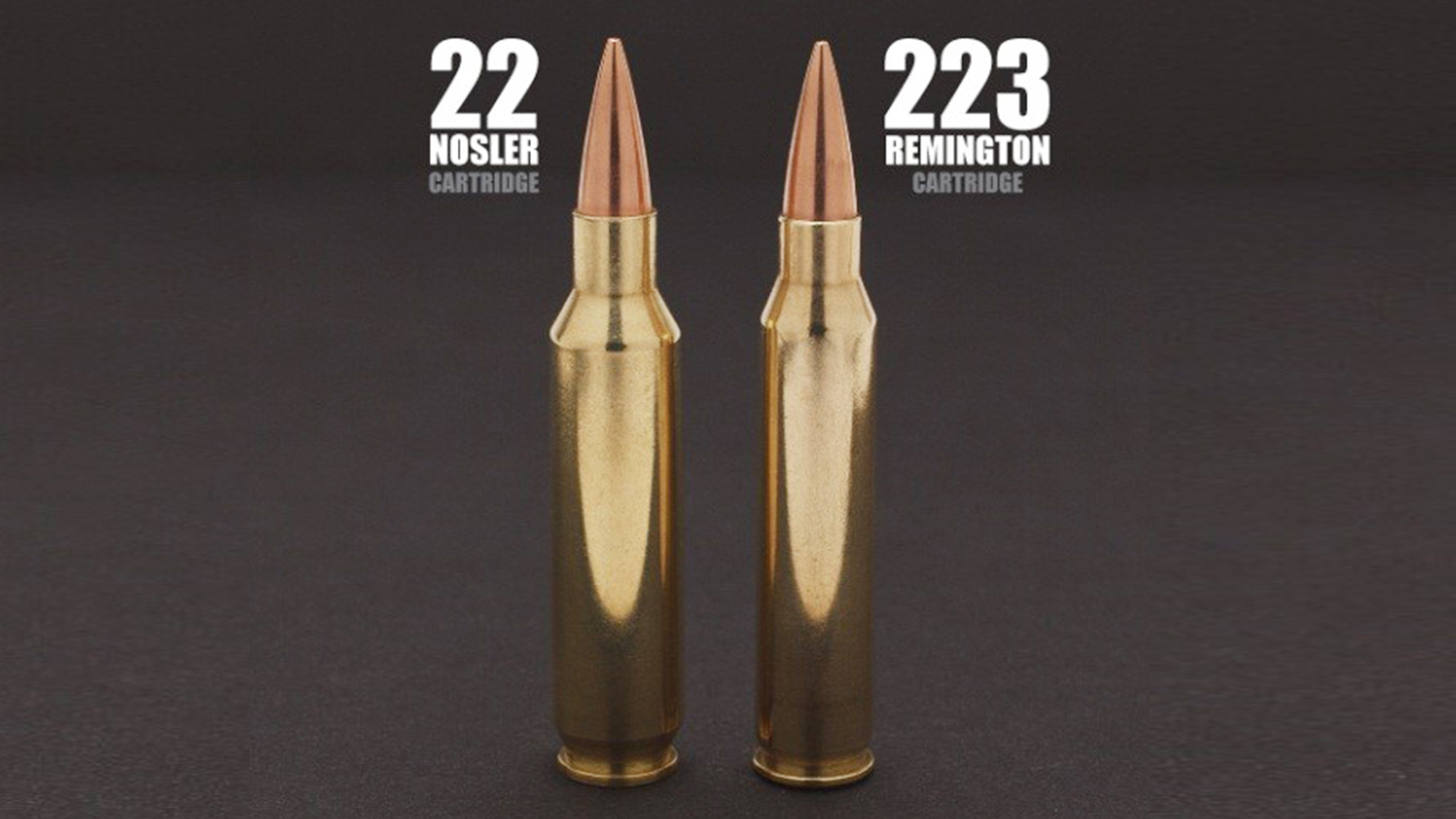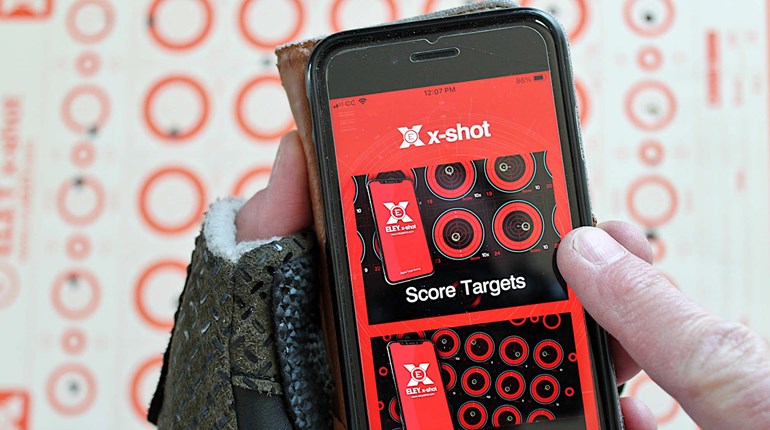
I am perhaps remiss in not reporting to you months ago Nosler’s introduction of the 22 Nosler cartridge at the January 2017 SHOT Show, but I felt the matter lacked any imperative for competition shooters. If you subscribe to American Rifleman, you’ve read a very informative article in the July issue on the cartridge, calling it a “relevant innovation” and including an opinion that it will soon appear on the firing line at the National Matches. I can’t improve upon detailing the cartridge specifics as found in the American Rifleman article, so I refer you there for that information. Here, suffice it to point out that 22 Nosler bullet velocity exceeds .223 Remington by about 300 fps at the muzzle, and its slightly larger case is conducive to launching longer/heavier .224-inch bullets at velocities exceeding the capability of the Remington round.
Frankly, however, it doesn’t seem likely that competition shooters will widely embrace the 22 Nosler, as its velocity advantage over the .223 Rem. may not be enough to compensate for its other limitations. Or, said another way more fair to Nosler, the courses of fire and other requirements of the various competitions limit the 22 Nosler’s advantage to a degree that rebarreling and buying yet another set of reloading dies and proprietary brass and working up new loads doesn’t make the cutoff of diminishing returns. And for many formal competitions, the cartridge simply isn’t permitted by rules.
Sniper games?
For example, the 22 Nosler’s selling point is its deliberate intent for the AR-15 platform—the reason for its rebated rim—and in NRA High Power competition we shoot AR-15 Service Rifles out to 600 yards, where that additional velocity or a heavier bullet would be quite desirable. However, High Power rules require that AR-15/M-16s in the Service Rifle class be chambered specifically in 5.56 NATO/.223 Remington only. An AR-15 firing the 22 Nosler would have to be bumped up into the Match Rifle class where the platform does not compete well against the greater inherent accuracy of bolt action tube guns. The 22 Nosler might find a home in a High Power Match class bolt action rifle, but the 22 Nosler’s performance does not improve upon the 6 mm and 6.5 mm cartridges with their fast, heavier-than-.224-inch high BC bullets already being used successfully in Match class rifles.
Similarly, the new cartridge isn’t legal for Palma competition, where only the 7.62 NATO/.308 Win. and 5.56 NATO/.223 Rem are invited. You could shoot the 22 Nosler in NRA Long Range competition, but it isn’t a 1000-yard cartridge—and Nosler doesn’t claim it to be—and it’s completely outclassed by every cartridge already in competition at that distance. One might have fired a 22 Nosler-chambered NRA Any Sight Match Rifle/Tactical Rifle in a High Power match under Rule 3.3.2, but NRA deleted that class of rifle from the rule book this year. How about NRA Silhouette? Nope—minimum centerfire calibers there are 6 mm. CMP Modern Military Rifle games? Nay again—nobody yet makes a production AR-15 in 22 Nosler, one of the rifle eligibility requirements, and at that competition’s short 100- and 200-yard limits, the 22 Nosler’s higher velocity is unnecessary, anyway.
A home on the range
In any competition at ranges less than perhaps 300 yards the 22 Nosler’s velocity alone isn’t really a significant advantage. So, what job does that leave the 22 Nosler at the range? It might possibly challenge the 6 mms that dominate 300 Meter competition, if that game gains popularity in the United States. The Nosler’s extra power might be helpful in toppling steel silhouettes in non-NRA games that may permit centerfire .22s—if any. Perhaps the place for the 22 Nosler to shine in competition is in sniper-style games that call for engaging steel plates at unknown distances, where a flatter trajectory (see chart below) and higher velocity can compensate for slight misjudgments by the shooter who also wants a light-recoiling cartridge.

The Precision Rifle Series
PRS may also be a good home for the new Nosler round. The PRS 2017 rulebook appears to permit a 22 Nosler AR-15 as a Gas Gun Open Division rifle. Firing distance runs from 300 to 600 yards—right where the 22 Nosler’s flatter trajectory really begins to pay off. In 3-Gun competition the distances vary with the particular match, but most firing is at 100 yards or less, and only a small fraction goes out to 300 yards or more. However, because the 22 Nosler has significantly less drop than the .223 Rem. at extended ranges, that’s precisely where the bigger 22 can win a match.
Nosler Public Relations Manager Zach Waterman said he queried some of Nosler’s pro-staffers to see what they’ve heard and seen in competitions regarding the 22 Nosler so far this year. “They said … several people have described their 22 Nosler [AR-15] builds they are in the process of for both PRS and 3-Gun,” Waterman said in an email exchange. “However, we’re the only ones I know already actually using it. I think you’ll see that change dramatically over the next few months as people finish their builds and learn the rifle’s holds (drops and windage) so they’re ready to use them in actual competition.”
New games, new rules
The 22 Nosler’s real advantage over the .223 Rem. in competition may be found in utilizing the very heaviest/high BC bullets of 80-grain and 90-grain (several custom makers also offer 100-grain bullets) fired at what is considered long range for the .223 Rem., 400 to 600 yards—and maybe beyond. However, I am not aware of any formal competition that would permit the 22 Nosler that doesn’t also permit cartridges that already outperform the 22 Nosler’s apparent abilities at extended ranges. So it appears we may have to create new games—or change existing rules—specifically to accommodate the 22 Nosler.

Of course, I may have missed something here. Maybe the 22 Nosler has a better-than-.223 Rem. application to your particular sport for a reason I don’t know because I don’t shoot your game and nobody knows everything about all competitions under the sun.
Cost vs benefit
If so, then the next question becomes, “Is it worth it?” Factory 22 Nosler Match grade ammo with 70-grain bullets is on price par with similar quality .223 Rem. at about $1.30 per round. Fair enough. For handloaders, the lowest price on new Nosler brass I found online is 60 cents apiece in quantity. Again, not too shabby, considering Nosler’s quality brass. But unlike with .223 Rem. and other established competition rounds, there is no other optional source for brass at this time. The 22 Nosler has no parent cartridge so we can’t readily form brass from something else, either. Die makers RCBS, Redding and Hornady all list the dies and Nosler lists loads up through 77-grain bullets online. Of course 22 Nosler loads use more powder than .223 Rem. loads, but that’s not a detracting point because we already accept that as the price for higher performance.
But we must consider the cost of rebarreling, unless we can find a gunsmith to set back, rethread and rechamber our existing barrel for less—which may not be cost effective anyway if we’ve already put more than a few rounds through it: Nosler says a competitor can expect a 22 Nosler barrel life of only “about 2,000 rounds,” so an active competitor who practices will need to buy a new barrel every other season or so, depending. To protect our rifle’s gas components, Nosler recommends we buy an adjustable gas block (about $60-$100), as the new round generates about 14 percent more pressure than the .223 Rem. Taken altogether, we might as well just buy a separate complete upper and be done with it. Oh, and we’ll need 6.8 SPC magazines, as the Nosler round doesn’t feed well through our .223 Rem. mags.
Those expenses may be minor to you, or they may not be—only you can say. Certainly, we tend to spend quite a bit of money on our sport simply to try something new and interesting and in hopes it may give us a technical edge. A good time to change over from .223 Rem. to 22 Nosler is at our next rebarreling, when we’d have that expense anyway. And if we’re to shoot those 90-grain and 100-grain bullets well, we’ll probably need a custom rifling twist a bit faster than the 223 Remington’s fast 1:7, perhaps a 1:6.5 or so.
Nosler’s purpose for their new cartridge, as Waterman told me at SHOT Show, is to “get the most out of a .22 caliber in the AR-15.” Mission accomplished, and a clever bit of problem solving, indeed. As time passes, we’ll see what niches shooters find for it. But until we get different competitions or different rules, the 22 Nosler’s place to excel appears to be in the hunting fields, with few spots on the competition firing line at this time.


































